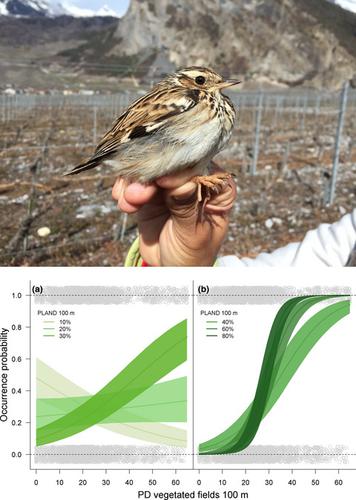当前位置:
X-MOL 学术
›
Anim. Conserv.
›
论文详情
Our official English website, www.x-mol.net, welcomes your
feedback! (Note: you will need to create a separate account there.)
Fragmentation effects on woodlark habitat selection depend on habitat amount and spatial scale
Animal Conservation ( IF 2.8 ) Pub Date : 2020-06-02 , DOI: 10.1111/acv.12604 L. Bosco 1, 2 , S. A. Cushman 3 , H. Y. Wan 4 , K. A. Zeller 5 , R. Arlettaz 1, 2 , A. Jacot 1, 2
Animal Conservation ( IF 2.8 ) Pub Date : 2020-06-02 , DOI: 10.1111/acv.12604 L. Bosco 1, 2 , S. A. Cushman 3 , H. Y. Wan 4 , K. A. Zeller 5 , R. Arlettaz 1, 2 , A. Jacot 1, 2
Affiliation

|
Habitat loss and fragmentation are key drivers of biodiversity loss. However, they are usually confounded, making it difficult to separate fragmentation effects from those of habitat loss. In addition, it has been shown that often fragmentation negatively affects biodiversity only below a certain threshold of habitat amount. We investigated the separate and interactive effects of habitat amount and fragmentation on habitat selection of the woodlark at 10 spatial scales. In southern Switzerland this passerine mainly breeds in ground-vegetated vineyards, which therefore represent the focal habitat type in this study. Additionally, we investigated land cover, topographic and climatic variables at the same 10 scales to obtain a holistic picture of species-habitat associations. Habitat selection was analyzed at two hierarchical levels: home range selection within the study area and habitat use within home ranges. Home range selection was strongly driven by an interactive effect of habitat amount and fragmentation: woodlarks avoided fragmented areas if habitat amount was below 20% but exhibited a preference for fragmented areas if habitat amount exceeded this threshold. Both habitat amount and fragmentation most strongly affected habitat use at the 100 m scale. We did not find such interactive effects for habitat use within home ranges. At this level, habitat amount at a 50 m scale influenced woodlark presence positively with no significant effects of fragmentation. Furthermore, woodlarks preferred evenly sloped landscape mosaics interspersed with steppes and groves. Two main insights emerge from our study. First, these results highlight the necessity of studying scale explicit and interactive effects of habitat amount and fragmentation when addressing ecological questions, such as habitat selection in birds. Second, we provide management recommendations for farmers: more vineyards should be vegetated and arranged as disjunct patches where their surface covers more than 20% of the landscape but be aggregated where vegetated area is lower.
中文翻译:

碎裂对林雀栖息地选择的影响取决于栖息地数量和空间尺度
栖息地丧失和破碎化是生物多样性丧失的关键驱动因素。然而,它们通常是混杂的,因此很难将破碎效应与栖息地丧失的效应区分开来。此外,已经表明,碎片化通常只会在低于特定栖息地数量阈值时对生物多样性产生负面影响。我们在 10 个空间尺度上研究了栖息地数量和破碎化对林雀栖息地选择的独立和交互影响。在瑞士南部,这种雀形目主要在地面植被的葡萄园中繁殖,因此代表了本研究中的焦点栖息地类型。此外,我们在相同的 10 个尺度上调查了土地覆盖、地形和气候变量,以获得物种栖息地关联的整体图景。栖息地选择在两个层次上进行了分析:研究区域内的家庭范围选择和家庭范围内的栖息地使用。栖息地选择受到栖息地数量和破碎化的交互作用的强烈驱动:如果栖息地数量低于 20%,林雀会避开破碎区域,但如果栖息地数量超过此阈值,则表现出对破碎区域的偏好。栖息地数量和破碎化对 100 m 尺度的栖息地利用影响最大。我们没有发现家庭范围内栖息地使用的这种交互影响。在这个水平上,50 m 尺度的栖息地数量对林雀的存在产生了积极的影响,而没有显着的破碎影响。此外,林雀喜欢散布着草原和树林的均匀倾斜的景观马赛克。我们的研究得出了两个主要见解。第一的,这些结果强调了在解决生态问题(例如鸟类的栖息地选择)时研究栖息地数量和破碎化的规模显式和交互影响的必要性。其次,我们为农民提供管理建议:更多的葡萄园应该种植植被,并排列成不连续的斑块,其表面覆盖超过 20% 的景观,但在植被面积较低的地方聚合。
更新日期:2020-06-02
中文翻译:

碎裂对林雀栖息地选择的影响取决于栖息地数量和空间尺度
栖息地丧失和破碎化是生物多样性丧失的关键驱动因素。然而,它们通常是混杂的,因此很难将破碎效应与栖息地丧失的效应区分开来。此外,已经表明,碎片化通常只会在低于特定栖息地数量阈值时对生物多样性产生负面影响。我们在 10 个空间尺度上研究了栖息地数量和破碎化对林雀栖息地选择的独立和交互影响。在瑞士南部,这种雀形目主要在地面植被的葡萄园中繁殖,因此代表了本研究中的焦点栖息地类型。此外,我们在相同的 10 个尺度上调查了土地覆盖、地形和气候变量,以获得物种栖息地关联的整体图景。栖息地选择在两个层次上进行了分析:研究区域内的家庭范围选择和家庭范围内的栖息地使用。栖息地选择受到栖息地数量和破碎化的交互作用的强烈驱动:如果栖息地数量低于 20%,林雀会避开破碎区域,但如果栖息地数量超过此阈值,则表现出对破碎区域的偏好。栖息地数量和破碎化对 100 m 尺度的栖息地利用影响最大。我们没有发现家庭范围内栖息地使用的这种交互影响。在这个水平上,50 m 尺度的栖息地数量对林雀的存在产生了积极的影响,而没有显着的破碎影响。此外,林雀喜欢散布着草原和树林的均匀倾斜的景观马赛克。我们的研究得出了两个主要见解。第一的,这些结果强调了在解决生态问题(例如鸟类的栖息地选择)时研究栖息地数量和破碎化的规模显式和交互影响的必要性。其次,我们为农民提供管理建议:更多的葡萄园应该种植植被,并排列成不连续的斑块,其表面覆盖超过 20% 的景观,但在植被面积较低的地方聚合。











































 京公网安备 11010802027423号
京公网安备 11010802027423号